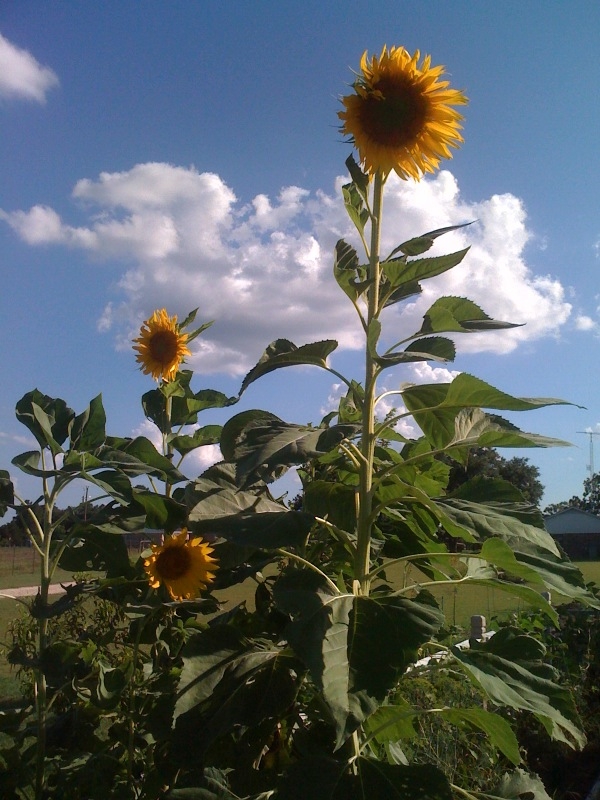Sunflowers and long beans at Boggy Creek Farms in Austin. Photo from their website
How many flowers do you grow that reach heights of ten feet, look great in the garden, last forever in a vase, and then feed you when it dries out? As far as I know, there is only one; sunflowers!
Sunflowers are native to North America. Indigenous people have grown them for thousands of years. Archeological evidence shows that tribes in Arizona and New Mexico were growing them around 3000 B.C. It is thought that the sunflowers were domesticated by Native Americans before corn. The Aztecs were so impressed with sunflowers that they actually worshipped them.
Even though Native Americans grew them first, the Russians are responsible for producing what we most often think of as sunflowers today. At last count, there are 82 species of sunflowers and countless numbers of varieties. According to the USDA, in 1991, 2.7 million acres of sunflowers were grown in the U.S. Commercial production is mostly for oil but considerable amounts are processed for human consumption, bird seed and cut flowers.
“Mammoth” sunflowers in the yupneck’s 2010 summer garden
How to Grow: If you want to grow really big sunflowers, plant your seeds as soon as night time temperatures do not drop below 50 degrees. Sunflowers love full sun. In fact, the more sunlight they get, the bigger the seed heads they will produce. 6 to 8 hours of sun is the minimum. Plant your seeds 1” deep in clumps of 5 or 6 that are spaced about 6” apart. These “clumps” should be spaced about 20” apart. Sunflowers are heavy feeders so make sure your bed is deeply worked with compost. Water your seeds regularly. With proper moisture, the seeds will sprout in 5 to 10 days. As your seedlings emerge, slowly begin to thin them. Cull the first bunch when the plants reach 6” in height. Leave about four plants. Cull the next bunch when the plants reach about a foot, leaving your best two. When those plants get 2’ tall leave only the best. If your sunflowers are grown to close together, they will produce shorter stalks and smaller heads. Plant them too far apart and they may get so tall that the stalk will not be able to support the weight of the seed head.
Very few plants in my gardens give me as much enjoyment as sunflowers. To me nothing says “summer in the country” better than a galvanized bucket full of the bright yellow heads on our dining room table. I am fast approaching the age when grand children will soon begin to follow me into my garden. Sunflowers will be the first plant that I use to get the next generation of gardeners in our family excited about growing things. I can’t wait to see the wonder in their eyes as they watch that tiny little seed turn into a mighty sunflower!




Being frugal, I plant along the ‘far’ backside of my garden and yard black oil sun flower seeds scavenged from chicken scratch I feed my chickens. They are a late season bloomer getting 6-8 feet tall and about 4-6 feet wide covered in 4-5 inch blooms. Coming from a hybrid black oil seed they revert to one of its parents genetics looking nothing like a oil seed sun flower.
Without staking, Mammoth – sunflowers seldom stand up to our sometimes very windy conditions in southwest Oklahoma.
Sun flowers of any kind is a great addition to any landscape.
Happy gardening
Great tip. The Antique Rose Emporium in Brenham grew the very sunflowers you are growing last year. They were lovely, especially in mass.